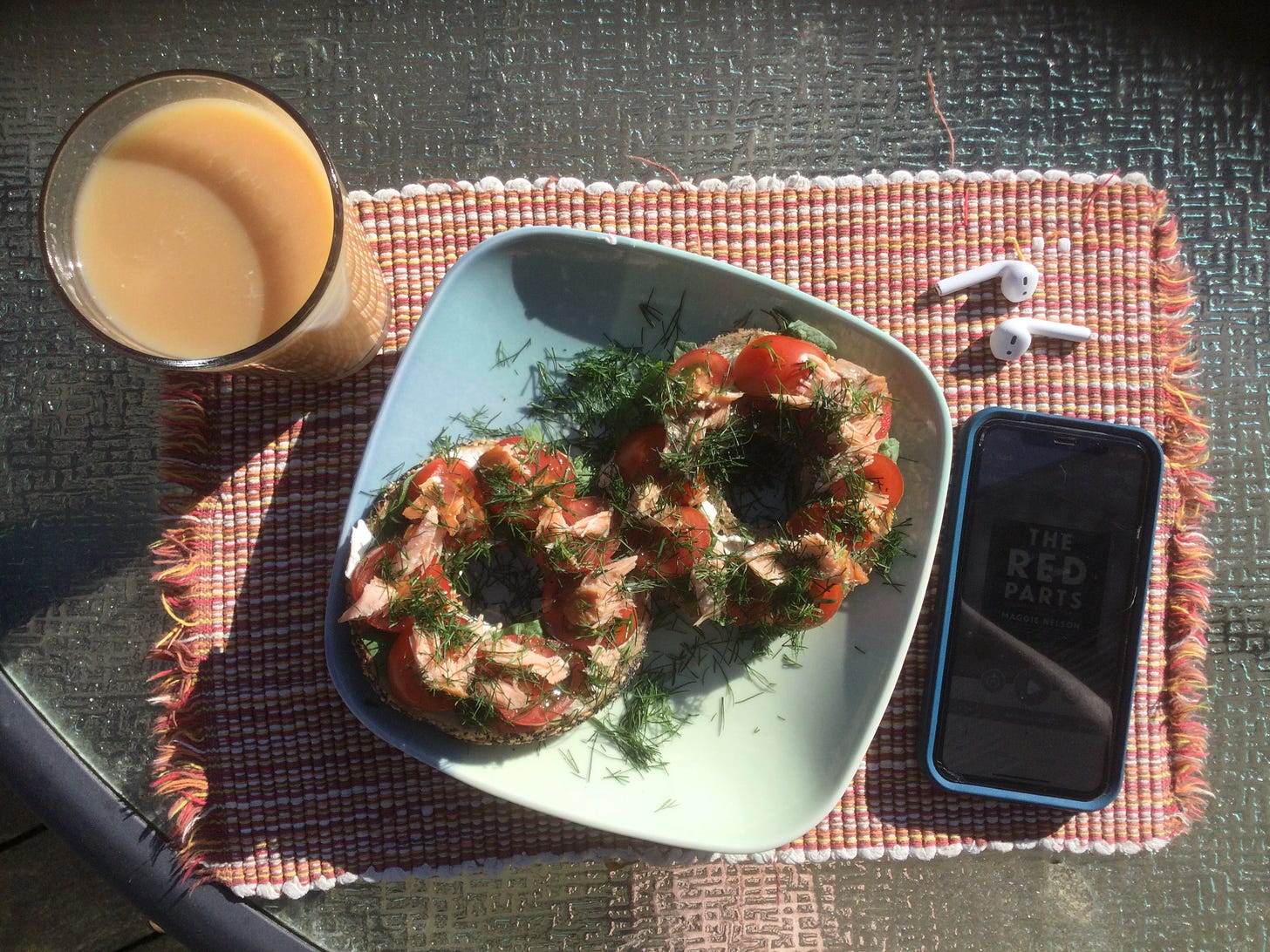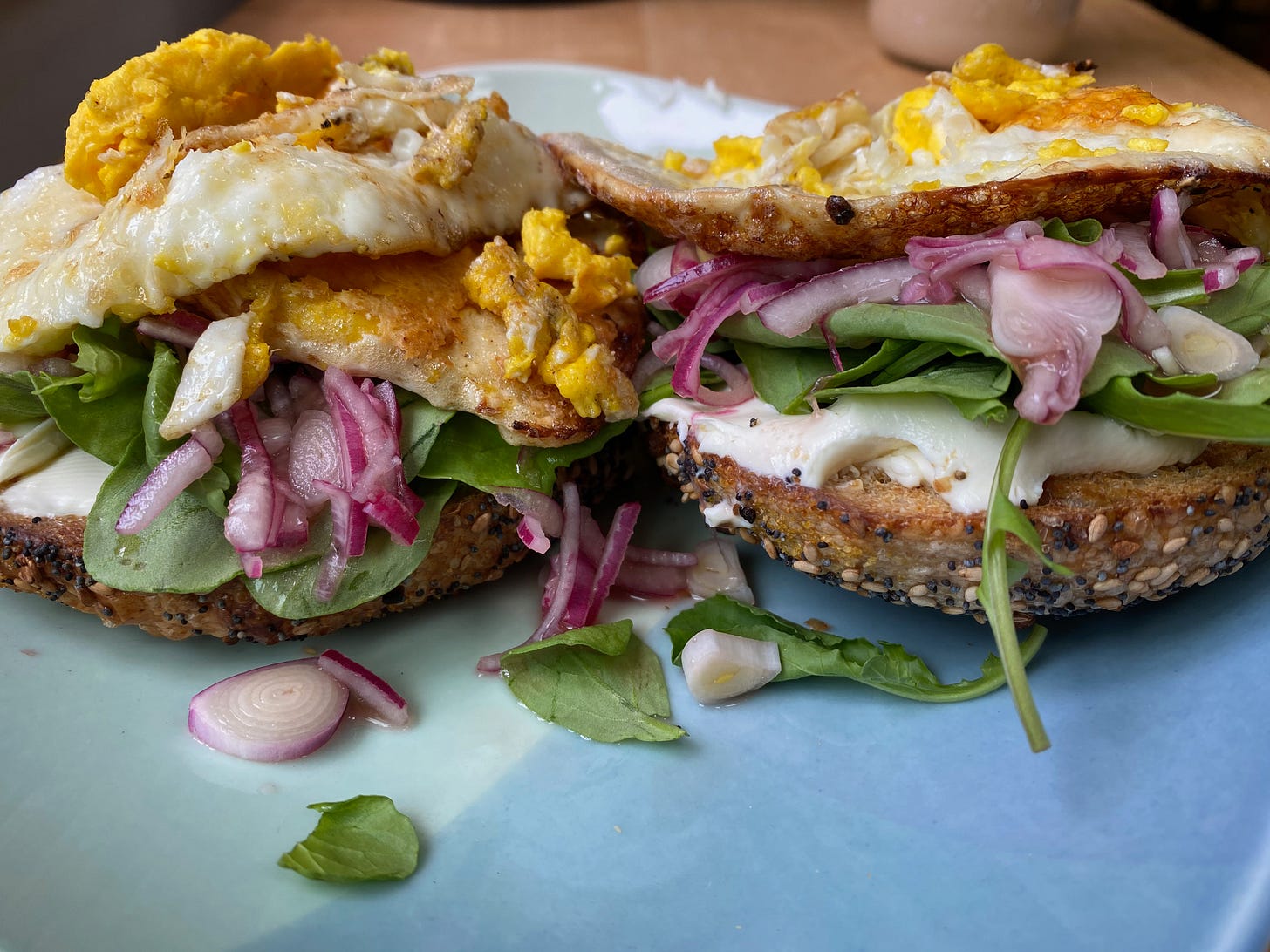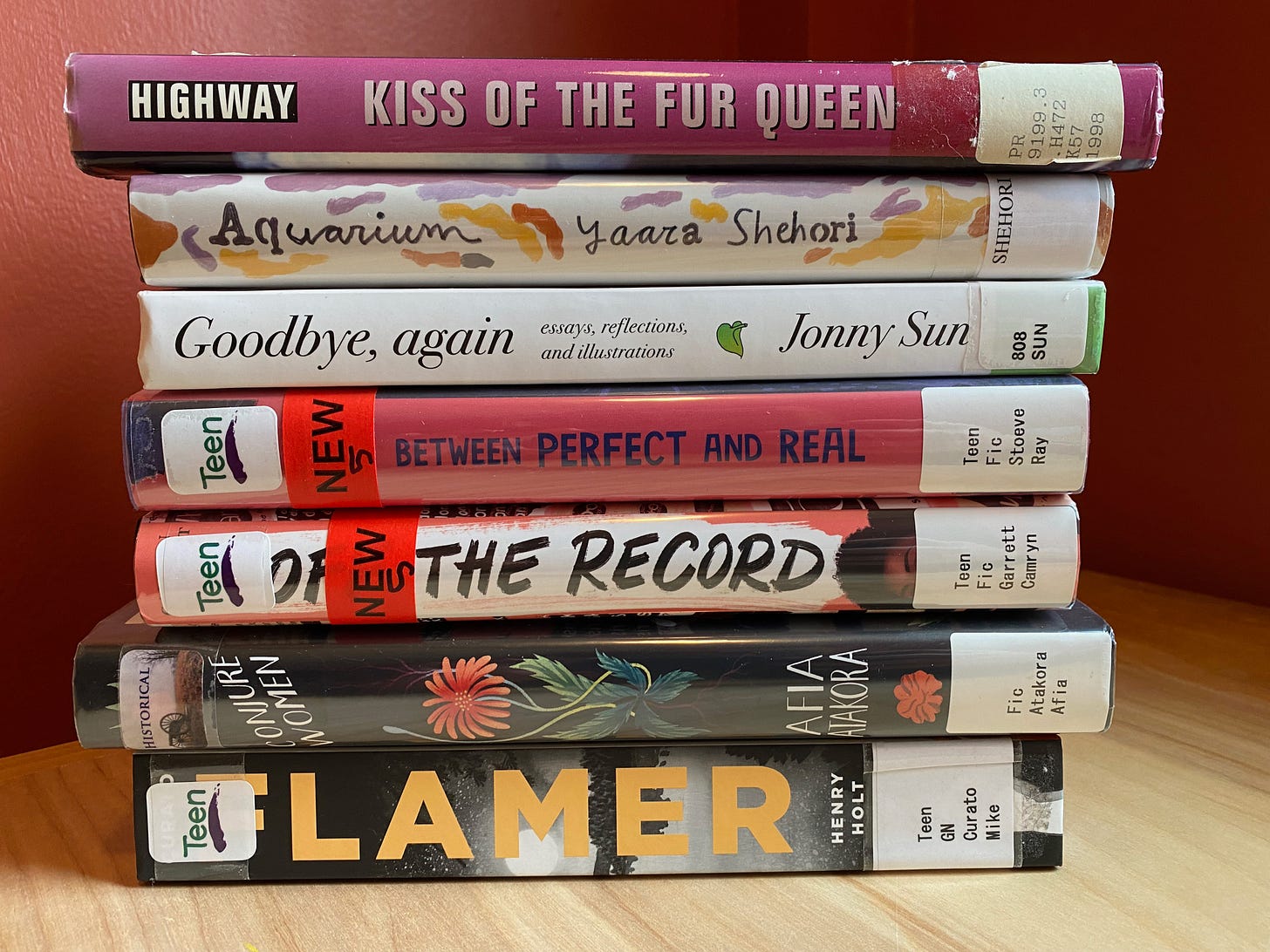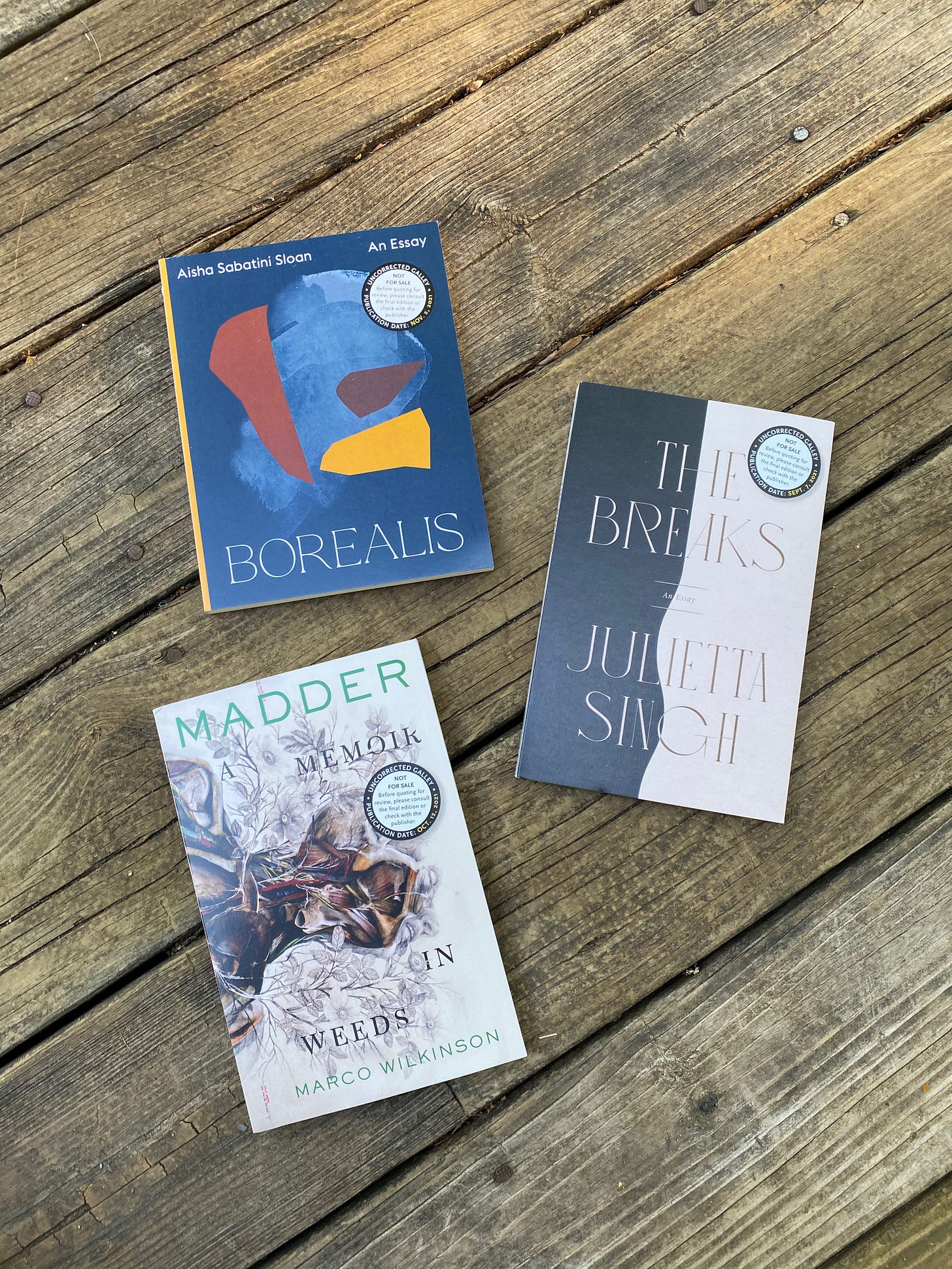Volume 1, No. 16: Not Your Standard Epistolary Books + Tahini Caramel Cookies
Hello, book and treat eaters! It is hot again. Also, I moved! I’ve still got a great newsletter for you today, something I’m quite proud to have accomplished amidst stacks of boxes and 95 degree heat.
This week, we’re talking epistolary books. This theme came about because I just read Summer Fun and I want to scream about it to everyone, so, naturally, here I am, screaming. Thornton works some truly strange and wonderful magic with the epistolary format, and that got me thinking about other books that play with this form in unique ways. So, let’s get to it!
The Books

Backlist: To Night Owl From Dogfish by Holly Goldberg Sloan and Meg Wolitzer (Middle grade fiction, 2019)
This middle grade novel isn’t especially revelatory in terms of the form it takes. Sloan and Wolitzer aren’t inventing new ways of writing epistolary novels. It is, however, continually surprising and delightful.
I picked this up expecting a fun, heartwarming story about two kids forming an unexpected friendship. What I got was a deeply moving and often surprising ode to queer family. There are summer camp shenanigans, sure, and plenty of humor, and yes, it is absolutely a feel-good story. But it’s not a simple one. Families are complicated, and this is a wonderfully honest portrait of a complicated queer family in the making.
The story unfolds entirely through letters and emails, mostly between two twelve-year-old girls, Bett and Avery. They live on opposite coasts, and don’t have a whole lot in common besides that they’re both being raised by single gay dads. They get in touch when they discover their dads have started dating, and agree to do everything in their power to sabotage this inconvenient relationship. So they are not pleased when their dads announce they’ve fallen in love, want to be a family, and are sending Bett and Avery to the same summer camp so that they can get to know each other. Of course, nothing goes to plan.
As far as the epistolary aspect goes, it’s exceedingly well done. The bulk of the book is emails and letters between Bett and Avery, which is an intimate way to witness their changing relationship. But the book also includes letters and emails from various supporting characters: their dads, the camp director, Avery’s birth mother, Bett’s grandmother. These cameos add depth to the story without taking away from the main event: Bett and Avery.
Bett and Avery are fantastically well-drawn twelve-year old girls. They’re both a mix of so many things: petty, brash, scared, self-absorbed, loyal. Bett it is outgoing and confident, while Avery is quieter and approaches everything with intense focus. Both of them are fully realized humans with their own particular quirks and obsessions. It is a joy to watch them clash, and then slowly show each other the parts of themselves they hide from the world.
I love queer books that upend mainstream narratives about queerness and queer families. It’s something I happily encounter quite a lot in adult novels, but it’s rare to come across it in a middle grade book. (Granted, I don’t read a ton of middle grade, so maybe I’m missing out.) But this novel does just that. It’s a treat.
Frontlist: Dear Senthuran by Akwaeke Emezi (Memoir)
This astonishing memoir is a collection of letters to the people in Emezi’s life: friends, lovers, mentors, family. Each letter is its own small work of art. They’re also vulnerable and honest, sometimes painfully so. Emezi uses the epistolary form to hold conversations. They write to specific people to discuss specific things: art, love, godhood, trauma, desire, transness, money, writing, home.
All published books are, to a certain extent, written for an audience. It’s unavoidable. But more than any other book I’ve read, this one feels like it was made for the self. Emezi made the work because making the work is what they do. They’re not interested in what you or I or anyone else thinks about it. A part of me doesn’t even want to review it, because reviewing it feels…redundant? Unnecessary? I’m not sure. At the same time, this is a book that asks for engagement, craves it. It’s a book that wants to be seen—but if you refuse to see it, if you can’t see it, well, your loss. Emezi is not going to explain themself for us.
This tension is one of the many contradictions this book holds. It’s a memoir about being an ogbanje, an embodied spirit, a nonhuman living in human flesh. But it’s also about the publishing industry, about money and MFA programs, about material safety and reveling in the physical. It is fearless and it is also about fear. It is about staying alive and about welcoming death. Emezi doesn’t pick and choose which parts of themself to write down on the page. They write it all down.
Getting to experience art like this is a gift. Emezi takes up so much space, and it’s the kind of space the world does not want Black trans queer people to take up. Their writing is so good, and they are so sure of themself. There’s rawness in it, but it’s also grandiose, extravagant. They use the word opulent a lot. Their expansive confidence, their demands for the time and love and money they want and deserve, their utter surety in their own talent—these are all things that make whiteness uncomfortable. I suspect there are some reviewers out there talking about Emezi’s arrogance and brashness. But labeling this work arrogant is just another way the white supremacist heterosexist patriarchy tries to disappear people and experiences that refuse to adhere to its demands.
Emezi isn’t just one thing and so this book isn’t either. There are these gloriously expansive passages, Emezi taking the world in their hands and tucking in. There is also a lot of deep pain. They write about transphobia, the difficultly of accessing gender-affirming health care, the alienation and despair they felt during their MFA program, and a suicide attempt. It is not an easy book; it is raging and lonely and exuberant.
I talk a lot about world-opening books. Emezi talks a lot about creating worlds. Their experience on this earth is so vastly different from mine. I will never understand it. There’s a lot in this that I simply can’t relate to. But being able to relate to it isn’t the point. That’s not what I mean when I talk about world-opening books. I also don’t mean books that have something to teach me, or books that change my perspective. What I mean is books like this, that remind me the world(s) will always be more vast than my understanding of it.
Upcoming: Summer Fun by Jeanne Thornton (Fiction, Soho Press, 7/27)
I read this book a few weeks ago and I can’t stop thinking about it. It is funny and strange and magical. I don't want to tell you much about it, because it’s also a spell, one whose power slowly builds. I didn’t know where it was going, but when I got to the end, I could look back at the journey—wild, bizarre, inimitable—and see clearly all the twist and turns.
Very basically, the story is about Gala, a trans woman who works at a hostel in a small New Mexico town. She spends a lot of time writing letters to the mysterious lead singer of her favorite 1960s pop band, the Get Happies. The entire book is told through these letters that Gala writes to B—. In some, she reflects on the daily goings on of her life: her work, her relationship with her one trans woman friend, her budding romance with a mysterious filmmaker. The rest of the letters are about B—’s life, the Get Happies, and why they stopped making music.
The story is told from Gala’s POV. She writes directly to B— in the second person. But she inhabits B—’s thoughts and feelings as if they were her own. Structurally, it’s the kind of thing that doesn’t always work for me, but Thornton pulls it off brilliantly. There is no narrative distance between Gala and B— . The POV is so close that it’s often dizzying.
The whole novel is essentially a conversation between these two trans women living in different decades. Even though Gala is the only one doing the talking, Thornton makes it feel like a two-way conversation. Perhaps because it feels that way to Gala. And it’s such a complicated and layered conversation! Gala and B—, through some mysterious alchemy, talk about trans identity and music, obsession and manifestation, friendship and fame, queer lineage, making art and making self.
Gala is a fascinating character, obsessed and self-aware, sad and creative, often cynical. She’s constantly making astutely funny observations about ordinary life. But she’s also got this optimistic ferocity to her, and it’s clear her understanding of and feelings about B— are not just a fan’s obsession, but something deeper and truer, more profound and more dangerous.
I often think about queer and trans ancestors. What they have to teach us, what stories they might tell us if they were alive. This book made me think about what I might want to tell them. Mostly, that’s what this novel is: Gala’s collection of love letters to her trans ancestors. But they’re real love letters, prickly and heartbreaking, angry and grateful and yearning. They create a lifeline between Gala and B—, a shifting rope made of story and memory. Something to hold on to. Maybe something to let go of, as well.
I could write about this book at length. If you read it, I would love to chat about it. It’s out July 27th and you can preorder it here.
The Bake
I bake all the things, but my first love will always be cookies that I can mail to friends. This is one of my favorite cookies to bake, eat, and, of course, mail. It’s inspired by a peanut butter cookie recipe by David Lebovitz. I tweaked it a bit, replacing the peanut butter with tahini, and I fill it with the most luscious tahini caramel from Sweet. Friends, this cookie is perfection.

Perfect-for-Mailing Tahini Caramel Cookies
Makes about 30 cookies
Ingredients
For the cookies:
8 Tbs (115 grams) unsalted butter, at room temperature
120 grams (1/2 cup) brown sugar (light or dark)
100 grams (1/2 cup) toasted sugar (untoasted is always fun)
1 egg
1 tsp vanilla
200 grams (3/4 cup) tahini
250 grams (1 3/4 cups) all-purpose flour (I usually use 150 grams AP and 100 grams whole wheat pastry)
1/2 tsp baking soda
1/4 tsp salt
2 Tbs each black and white sesame seeds (the cookies will still be delicious if you only have white)
For the tahini caramel:
200 grams (1 cup) sugar
1/2 cup (120 ml) water
7 Tbs (100 grams) unsalted butter, at room temperature, cubed
1/3 cup (80 ml) cream
150 grams (1/2 cup + 1 Tbs) tahini
1/4 tsp flaky salt
Make the cookies: Preheat the oven to 350. Line two baking sheets with parchment or silicone baking mats. In a stand mixer fitted with the paddle attachment, or with handheld beaters, cream the butter and sugars until smooth, about 3 minutes. Beat in the egg and vanilla. Scape down the sides of the bowl and mix in the tahini.
In a small bowl, whisk together the flour, baking soda, and salt. Add the dry ingredients to the tahini mixture and mix on low speed just until the flour disappears.
Pour both kinds of sesame seeds into a small bow. Using a tablespoon, scoop portions of dough and roll them into smooth balls between your palms. Drop the balls into the bowl of sesame seeds, rolling them around until they’re completed coated.
Place about 1 1/2” inches apart on the prepared baking sheets. Using your thumb, make small depression in the center of each cookie. Don’t worry if the sides crack; just squeeze them back together.
Bake for 13-16 minutes, rotating the sheets after 7 minutes. The cookies should be golden brown and the edges just set. Remove them from the oven and use a wooden spoon to reinforce and widen the depressions. Let cool.
Make the caramel: Measure out the butter, cream and tahini and set aside. Place the sugar and water in a small saucepan over medium-low heat, stirring occasionally, until the sugar dissolves. Increase the heat to medium-high and bring to a steady boil. Let boil for about 10 minutes—you’ll know the caramel is ready when it turns a deep, rich amber color. Remove from the heat and add the butter and cream. It’ll splutter and sizzle, so be careful. Whisk to combine. Once the butter has melted, stir in the tahini and salt. Let cool slightly before using.
Assemble: Once the cookies have fully cooled, spoon a dollop of warm or room-temperature caramel into each depression. If you’ve waited too long and the caramel is hard to pour, reheat it gently on the stovetop or in a microwave. You can eat the cookies right away, but let them sit for a few hours so the caramel can set before mailing them. They’ll last for at least a week.
The Bowl & The Beat
The Bowl: How to Turn a Bagel Into Dinner
I am in the middle of moving as I write this. I mean, I’m not currently unpacking boxes, but my new house is full of them and my kitchen is in disarray, which is not conducive to cooking. Luckily, I’ve been eating well anyway, mostly thanks to the amazing bagels from my local bakery. It is so easy to make a meal out of a bagel! Here are a few of my recent favorites:
Cream cheese, sliced tomatoes, smoked salmon, and lots of dill. Other additions I’ve been enjoying with this combo: scallions, spinach, fried eggs.

Cream cheese, arugula, quick pickled red onions (slice an onion, put it in a bowl with a pinch of sugar, a pinch of salt, and a few glugs of sherry vinegar), and fried eggs.

Other favorite bagel meals: pesto, sun-dried tomatoes, and melted mozzarella; ricotta, sliced tomatoes, pickled onions, and basil; cream cheese, sliced cucumbers, arugula, dill/parsley/basil, and red pepper flakes.
The Beat: L.A. Theatre Works Audio Plays

I review audiobooks for Booklist, and I recently listed to two amazing plays, No-No Boy by Ken Narasaki and For Us All by Jeanne Sakata. Earlier this year I listened to The Thanksgiving Play by Larissa FastHorse. All of these audio plays are produced by L.A. Theatre Works, and I have loved every single one. The Thanksgiving Play is available now from Libro, and the other two are coming this summer. They’re just $6.95 each, and I honestly can’t recommend them enough.
The Thanksgiving Play is a hilarious and scathing satire about a group of white teachers tasked with creating a Thanksgiving pageant at their school. Both No-No Boy and For Us All deal with the mass incarceration of Japanese Americans during WWII. No-No Boy is about a Japanese American man who returns home to Seattle after being imprisoned for resisting the draft. For Us All is set in the 1980s, and it’s based on the true story of the team of mostly Japanese American lawyers who worked to overturn the conviction of Fred Korematsu, who was imprisoned for resisting incarceration during the war.
I was astounded by the quality of these productions. The actors are all superb, as are the audio effects, music, pacing, etc. Listening to these plays felt like being at the theatre. I’d never given much thought to listening to plays before being assigned these titles to review, and now it’s one of my favorite things. I’m excited to check out the rest of LATW’s 2021 Audio Theatre season.
The Bookshelf
The Library Shelf
I went into my new local library for the first time last week! It has been over a year since I’ve been inside a library, beyond stepping into the foyer to pick up books. I may have gotten overexcited. It was such a delight to browse library shelves again, even though the chances of me actually reading all of these are slim.

The Visual
I got a delightful batch of upcoming books from Coffee House Press this week, the first bookmail (or mail of any kind) I’ve received in my new house!

Around the Internet
Author Callum Angus has a great newsletter, and this week’s issue was a particularly good read.
Now Out
No new books that I’ve previously recommended are out this week. But you can always browse all the books I’ve mentioned in this newsletter at the Books & Bakes Bookshop.
The Boost
Since we’re talking letters this week:
Black and Pink is a national LGBTQIA2S+ prison abolition organization. Their pen-pal program pairs free-world people with incarcerated LGBTQ+ people to “correspond, build relationships, and participate in harm reduction and affirmation.” Friends of mine have become penpals through their MA chapter, and it’s something I plan on doing this year as well.
A coworker of mine has been posting pictures of Postcrossing postcards she’s gotten from all over the world—she’s been asking folks for book recommendations! This seems like a fun and gentle hobby.
As always, a little bit of beauty to send you on your way: I finally got my community garden plot planted! It is now full of flowers and mulched as well. This is a little bouquet I made after going through the garden, snipping off blooms to encourage more plant growth.

And that’s it for the week. Catch you next Wednesday!



